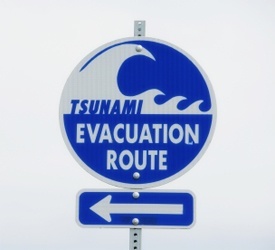![]()
Tsunami States
Tsunamis can occur anywhere along the United States coastline, but are most likely to strike along the coasts of Alaska, California, Oregon, Washington, and Hawaii.
About Tsunamis
Tsunamis, sometimes referred to as seismic sea waves or incorrectly as tidal waves, are abnormally large ocean waves that can reach heights of 100 feet tall and travel at speeds of up to 500 miles per hour. They are usually triggered by underground volcanic activity and earthquakes, but can also occur from undersea landslides or even nuclear explosions.
Tsunamis are difficult to detect at sea because they are only a few inches high. As a tsunami approaches land, the height of the wave increases while at the same time, the water at the shoreline recedes.
While tsunamis are difficult to detect, there are systems in place that provide some early indications that one is eminent or on its way. When a tsunami is detected, or if a possible trigger even occurs, a warning is issued to areas impacted by a possible strike.
Types of Tsunami Warnings
Advisory - An earthquake occurred in the Pacific Ocean, which might trigger a tsunami.
Watch - A tsunami was triggered, but is two hours or more travel time away from the area in Watch status.
Warning - A tsunami is most likely on its way that can cause damage; People in the warned area are advised evacuate.
Important Survival Tips for Tsunamis
- Understand the terms that identify a tsunami hazard: advisory, watch and warning.
- If an earthquake occurs, listen to your radio for Tsunami warnings.
- If you notice a dramatic recession of costal water from the shoreline you should seek higher ground inland immediately.
- Following a tsunami, move inland and do not return to impacted areas until officials say it is safe.
Preparing for a Tsunami
Being prepared for a tsunami or any other type of disaster requires preparation beforehand. There are three important steps you should complete in preparation for a tsunami. To make this even easier, Essential Packs provides you with a FREE online Emergency Preparedness Planning Guide that takes your step-by-step through the process:
Having the proper emergency preparedness kit, having a plan, and knowing what to do before a tsunami strikes, will greatly improve you and your family’s chances of being safe. Complete the 3-Step Emergency Preparedness Planning Guide today!
Get A Tsunami Survival Kit
Getting an Emergency Preparedness Kit for your home, office (or school), and car(s) is an essential first step in being prepared for a tsunami. Emergency Preparedness Kits from Essential Packs, provide you and your family with the emergency supplies your family needs to last for 3 days (72 hours). Deluxe Kits from Essential Packs are compliant with FEMA's guidelines and include important items like: emergency food and drinking water, flashlights, radios, first-aid supplies, sanitation supplies, emergency blankets, waterproof ponchos, and much more.

For additional help on selecting the right kit, visit Step 1 - Get A Kit of our Emergency Preparedness Planning Guide.
Make a Plan
In order to know what to do when a tsunami occurs, you need to create a Family Emergency Plan. Sit down with your family members and decide how you will get in contact with each other, where you will go, and what you will do in the event of a disaster or emergency.
To make this easy, Essential Packs provides you with a Family Emergency Planning Document that you can download for FREE. Simply open this PDF document and fill-in the blanks, then, print a copy for each family member, and store one copy in your Emergency Preparedness Kit.
You should update your Family Emergency Plan every six months, as phone number, work locations, and other important information could change.
For more help on creating a Family Emergency Plan, visit Step 2 - Make A Plan of our Emergency Preparedness Planning Guide.
Be Informed
The final step to getting prepared is to be informed about what to do before, during, and after a tsunami. FEMA's In-Depth Citizen's Guide to Disaster Preparedness helps you do this by providing you with comprehensive emergency preparedness information a variety of disasters.
Visit Step 3 - Be Informed of our Emergency Preparedness Planning Guide to download FEMA's comprehensive, 200 page book called, "Are You Ready? An In-Depth Guide to Citizen Preparedness".

